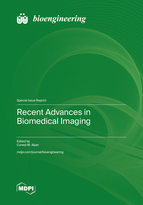Recent Advances in Biomedical Imaging
A special issue of Bioengineering (ISSN 2306-5354). This special issue belongs to the section "Biomedical Engineering and Biomaterials".
Deadline for manuscript submissions: closed (15 August 2023) | Viewed by 17603
Special Issue Editor
2. Department of Pediatric Otolaryngology, Children's Hospital of Pittsburgh of UPMC, Pittsburgh, PA, USA
Interests: imaging; biomedical imaging
Special Issues, Collections and Topics in MDPI journals
Special Issue Information
Dear Colleagues,
Biomedical imaging has arguably demonstrated the most rapid advancements in the entire biomedical field in the past decade. Besides the expansion of established imaging instrumentation into broader applications in tissue, cellular, and molecular diagnostic imaging, there have been substantial modifications in the imaging protocols that have advanced the capabilities of these existing imaging modalities. Technological advancements are stimulating further novel approaches in diagnosis and measuring as well as monitoring the outcomes of treatments. The adaptation of innovations in imaging technologies, methods, and protocols for broader applications is often limited by the inability to share an innovation with investigators outside the likely narrow field in which it originated. Therefore, it is crucial to facilitate the sharing of such advances in biomedical imaging occurring in one field with other fields. A broader vision with which to explore the full potential of an innovation often requires adding a new, perhaps outside, perspective. This Special Issue of Bioengineering aims to serve as a medium for such interdisciplinary exchange and the stimulation of the expansion of applications of innovations, perhaps through facilitating new collaborations between various fields and investigators. The next big thing in biomedical imaging may come from diverse minds finding new ways forward.
Dr. Cuneyt M. Alper
Guest Editor
Manuscript Submission Information
Manuscripts should be submitted online at www.mdpi.com by registering and logging in to this website. Once you are registered, click here to go to the submission form. Manuscripts can be submitted until the deadline. All submissions that pass pre-check are peer-reviewed. Accepted papers will be published continuously in the journal (as soon as accepted) and will be listed together on the special issue website. Research articles, review articles as well as short communications are invited. For planned papers, a title and short abstract (about 100 words) can be sent to the Editorial Office for announcement on this website.
Submitted manuscripts should not have been published previously, nor be under consideration for publication elsewhere (except conference proceedings papers). All manuscripts are thoroughly refereed through a single-blind peer-review process. A guide for authors and other relevant information for submission of manuscripts is available on the Instructions for Authors page. Bioengineering is an international peer-reviewed open access monthly journal published by MDPI.
Please visit the Instructions for Authors page before submitting a manuscript. The Article Processing Charge (APC) for publication in this open access journal is 2700 CHF (Swiss Francs). Submitted papers should be well formatted and use good English. Authors may use MDPI's English editing service prior to publication or during author revisions.
Keywords
- imaging biomedical
- imaging innovations in imaging
- advances in imaging CT
- scans MRI
- ultrasound nuclear medicine
- PET fluoroscopy
- interventional radiology
- combined imaging modalities







